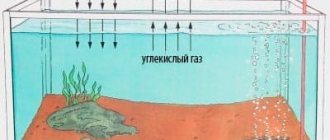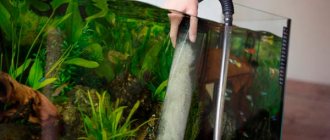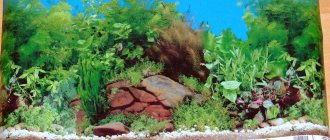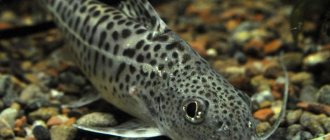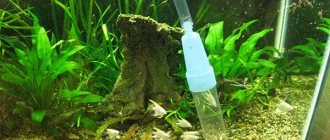- Blackbeard: why is this called an algae in an aquarium?
- Appearance of blackbeard algae
- Reasons for the appearance of a black beard in an aquarium
- How to identify a black beard in an aquarium
- What harm does black algae cause in an aquarium?
- Methods for eliminating black beard in an aquarium
- Mechanical
- Soil cleaning
- Water change
- Peroxide treatment
- Use of acetic acid
- Chemical methods for controlling black beard in an aquarium
- Use of purchased drugs
- Changing water parameters: increasing hardness and alkaline mode
- Carbon dioxide saturation
- Special antiseptics
- Harmless antiseptics
- Biological methods of combating blackbeard in an aquarium
- Proper aquarium care
- Plants against black beard
- Animal Enemies
- Introducing special fish and snails
- Restarting the aquarium: a way to deal with blackbeard in an aquarium
- Battery use
- Prevention measures against black beard in an aquarium
- How to avoid the recurrence of a black beard
- General rules for maintaining balance in an aquarium
- Video: black beard in an aquarium, how to get rid of algae
Uncontrolled algae growth is one of the biggest problems in an aquarium. In some cases, such processes can even lead to the destruction of a mini-ecosystem and the death of all inhabitants. In this article we will look at such harmful algae as blackbeard in an aquarium, how to get rid of it and how to prevent the parasite from appearing.
Black beard in an aquarium: photos, videos, how to get rid of algae.
If you encounter a black beard in your aquarium, then there is nothing very scary about it, but you will have to tinker with getting rid of it. What is it? Its scientific name is compsopogon coeruleus. Often a black beard is confused with a Vietnamese beard (red beard). But according to taxonomy, Vietnamese and black beard algae belong to the same department.
Appearance of blackbeard algae
Black beard in an aquarium is small black hairs on plants or any surface (from filter to ground), 0.5-5 cm long, representing a weave of black and green threads.
Black beard on a plant.
The black beard covers the leaves from the light.
Despite the black tint, the plant is not a brown algae, but a red algae. It is a representative of the genus Compsopogon, the species name is caerules. The threads of the parasite can be colored black-brown, dark gray or completely black. Algae settles on plants, driftwood, soil and decorations. At the beginning it has the appearance of moss, but under favorable conditions the length of the outgrowths quickly increases.
On a note! It does not pose any danger to fish. Slow-growing plants suffer first, because their leaves are closed from sunlight, the plant tissue itself is destroyed, which is why the plants actually suffocate.
How to remove "Blackbeard" from an aquarium
Many aquarists call the algae Compsopogon “blackbeard” or “flip-flop”. This peculiar-looking algae has become a real scourge for aquarists, and the fight against them can drag on for several months.
Compsopogon is recognized by anyone, even a novice aquarist. This algae, growing on the stems of other plants, substrate and walls of the aquarium, has the appearance of hard black brushes consisting of hairs from 5 to 20 mm long. Despite the fact that during its growth, “black beard” deeply affects the stems and leaves of plants, the algae is not a parasite, but uses the plant as a substrate for growth.
Algae, like other plants, require favorable conditions for growth and development. Once in an aquarium with new plants, the algae grows on stems and leaves, stones or auxiliary equipment, choosing illuminated places, although the algae is undemanding to an abundance of light. For active growth, compogon requires the presence of organic matter, hard water and a high pH.
Under such conditions, blackbeard tassels can form a dense carpet. In aquariums with clean and clear water, the algae practically does not reproduce, being located in separate “bushes” on the leaves of plants, stones and on the walls.
The fastest and easiest way to get rid of algae is to completely restart the aquarium: burn the soil and decorations, remove the affected plants, but not everyone will like such a radical way of dealing with “blackbeard”. A more logical and humane way to combat the invader is to create conditions under which compogonum will not be able to reproduce and grow, or at least stop growth. Stopping growth with this method of control is already an important success, but it is almost impossible to create conditions under which the algae begins to die instantly.
First of all, you need to deprive the algae of food. Since the “black beard” is completely rootless, it receives nutrition directly from the environment. The greater the volume of water that washes the algae tassels, the more nutrition it receives. Therefore, it would be advisable to temporarily remove all equipment that creates current - filters and aerators. You can also transplant from an aquarium those types of fish (mainly catfish) that occupy a bottom niche of existence and, in the process of feeding, raise substances accumulated in the soil to higher water layers, thereby feeding the compogon.
The abundance of nitrates and phosphates found in aquariums with old water are vital for the successful growth of compogonum, so about 30% of the aquarium water should be replaced every other day for several weeks. Ideally, it is advisable to wash the soil and decorations. After washing the soil and during the secondary rooting of aquarium plants, it is advisable to place fertilizers at the very root of the plant and increase the light intensity. Thus, we ensure that the plant itself, and not the compogon, receives nutrients. The goal of this work is to provoke increased growth of fast-growing plants, such as Vallisneria and Hygrophila, which will begin to “pump out” excess phosphates and nitrates from water and soil at an accelerated pace, thereby dooming compogonum to a stop in growth.
You should also think about the population of the aquarium. Large amounts of nitrates and phosphates accumulate in overcrowded aquariums. And this leads to an increase in rotting organic waste from fish. We will have to solve the problem with excess residents, otherwise the fight against the “blackbeard” will simply be fruitless. These simple conditions will allow you to rid your aquarium of black beard within 2-3 months.
But the fastest method can be considered a chemical method of combating “blackbeard.” The essence of the chemical method is to shift the pH of the aquarium water. Recipes with boric acid and borax are popular among aquarists. Indeed, leaching of water leads to a decrease in algae growth, but does not guarantee the complete destruction of blackbeard. But a pH shift can destroy not only the annoying algae, but also affect the condition and appearance of other plants or aquarium inhabitants. Moreover, the pH will need to be constantly maintained at the proper level, which is not always feasible.
Also in some literature it is recommended to use antibiotics, such as penicillin or bicillin, but unfortunately their use does not bring the desired result, they can only provoke a slowdown in the growth of many plants, and for some types of ferns and mosses, “antibacterial therapy” will simply be disastrous.
Currently, in many pet stores you can purchase a number of special preparations to maintain the desired pH. The effect of these drugs is visible almost immediately; on the 3rd–4th day of using the chemicals, compsopogon begins to crumble and stops growing. But you shouldn’t be happy that after a chemical attack the algae will leave the aquarium forever. Often, such drugs kill the “bushes” themselves, but the algae growth zones remain untouched, which is why the growth of the beard begins again and on a larger scale.
Experienced aquarists recommend combining these two methods of combating compogonum in order to completely clear the aquarium of this persistent and viable algae.
Reasons for the appearance of a black beard in an aquarium
An aquarium is a closed system, so if a new, not particularly welcome resident appears in it, this is a reason to sound the alarm. Often, aquarium lovers themselves can accidentally cause a beard to appear in their aquarium, since the reasons for the appearance are quite banal. Here are some of the possible ones.
The main reasons for the appearance of harmful algae:
- Lack of regular water changes. The more silt and dissolved organic matter in the water, the more rapidly the pest develops. In the presence of aeration, the rate of algae reproduction increases significantly.
- Overpopulation. The more inhabitants in the aquarium, the more they eat food and secrete waste products, which are desirable food for the algae. Overpopulation threatens with other dangerous phenomena, so it is very important to correctly calculate the number of fish, crustaceans and mollusks.
- The appearance of new plants is the most common reason why a black beard appears. Algae spores are brought with newly acquired plants, untreated preparations and those that have not undergone quarantine.
- Overfeeding fish. Rotting food residues provoke the rapid development of all types of algae and blue-green bacteria.
- Untimely or incorrect cleaning of the filter. The same applies to changing cartridges too rarely.
- Too frequent and intense siphon cleaning of the soil, which provokes the release of “preserved” organic matter from the substrate.
- Increased content of phosphates and nitrates in water. They get into the water with fertilizers for aquarium plants, when there is an excess of food or when the decomposition process of organic matter is disrupted.
Blackbeard is a very tenacious algae, so even professional aquarists are not immune from its appearance.
Reasons for appearance
Before you begin to fight the disease and cure it, you need to establish why it appears. Active growth of harmful algae can be triggered by many factors, but the main ones include the following :
- Irregular water changes - old water with a lot of organic matter is a favorable environment for algae. Silt on the ground is also attractive to it. If the aquarium has aeration, then this makes such an aquarium an ideal place for the development of black moss on the plants in the aquarium. It will be impossible to overcome without complete water purification.
- Overpopulation - fish secrete natural metabolic products and create a breeding ground for harmful algae in the water. The number of individuals in the aquarium must be calculated according to the rules.
- Planting new plants - if they are not pre-treated with antiseptic drugs, then with a high degree of probability you can introduce a large number of blackbeard spores into the aquarium.
- Overfeeding fish - leftover food decomposes in the water and provides a breeding ground for the parasite. Overfeeding also causes the water to become cloudy.
- A compressor that is too powerful will lift sludge from the bottom and create favorable conditions for algae.
- Irregular filter maintenance results in additional nutrients being released into the black moss.
- Excessive soil siphoning will release organic matter from it, which plants feed on, but its excess can provoke the development of harmful algae spores. When using artificial plants, you need to siphon the soil weekly.
Even an experienced aquarium owner can encounter such a problem, forgetting about the rules for maintaining the reservoir. In beginners, the parasite settles, as a rule, due to inexperience.
How to identify a black beard in an aquarium
Sometimes it can be difficult to detect the appearance of a pest, but not in the case of a dark beard. This algae has a characteristic appearance and cannot be confused with anything else. If you notice black moss and wool, it means Compsopogon has long been introduced into your aquarium.
Detecting a black beard is quite simple - the appearance of black-green threads (fluffy shoots) on various surfaces or plants.
The closest relative of this parasite is “flip flop,” another harmful algae. Otherwise it is called “deer horn”. It is very different from its closest relative - it looks like bare trees in winter, only instead of branches there are thin tubes. Even if you are afraid of confusing a Vietnamese and a blackbeard (which is very difficult to do due to the completely different appearance of the pests), do not worry - these parasites can be removed using the same methods and means.
Red algae (black algae)
Black beard
The appearance of red algae indicates that the content of organic residues of fish and plants in the aquarium water has increased - what is called organic matter. One type of red algae is blackbeard.
Since she loves a high content of organic matter in water, methods of combating black beard are aimed primarily at reducing the level of this organic matter. To do this, you need, firstly, to remove organic residues from the soil (slightly siphon the soil surface). Secondly, increase weekly water changes to 50%, or do them altogether, because many people forget about changes.
A good method to reduce organic levels is to add activated carbon to the external filter. AQUAYER Algaecide + CO2 also helps a lot in the fight against black beard . To improve its effectiveness, you can carry out the listed procedures, but when using AQUAYER Algaecide + CO2, you must remove the activated carbon from the external filter. Among the living fighters with black beards, Siamese algae eaters .
Deer antler or flip flop
The Vietnamese usually appears during the start-up of the aquarium. It has the same causes of appearance as a black beard. And the methods of combating this algae are similar to the methods of combating black beard.
What harm does black algae cause in an aquarium?
Black algae is a real disaster for an aquarium.
The most dangerous consequences of introducing this parasite into an aquarium:
- The pest settles on the leaves and stems of slow-growing plants, destroying their soft tissues, leading to their death due to “wounds”. Often the beard even feeds on the juices of the plant on which it lives.
- The algae threads shade the plants, causing them to suffer from lack of light and begin to grow more slowly. Then the black misfortune completely envelops them.
- The parasite can turn particularly tender leaves into mush in a matter of weeks. Sometimes entire plantations of aquarium plant breeders die because of this.
Black algae does not cause direct harm to fish, but it leads to the formation of new foci of rotting at the site of damage and “wounds” of plants, which disrupts the overall balance, including phosphate and nitrate, which indirectly can lead to suffocation and poisoning of fish and shellfish.
Methods for eliminating black beard in an aquarium
There are different ways to fight black beard in an aquarium. They are combined into three large groups: mechanical, chemical and biological.
Mechanical
One of the most reliable, but time-consuming methods. If algae actively multiply, you will have to remove all the fish and clean out the aquarium for a long time. But there is a good chance that the algae will go away. Mechanical methods are also the least expensive.
Soil cleaning
It is effective only at the very beginning of development, if the algae are not affected, or there are so few of them that the parasite has settled on the ground. You can get rid of black algae in an aquarium using regular mechanical cleaning of the soil. You need to use a powerful siphon to clean the entire surface of the substrate as quickly as possible.
If possible, it is better to replace the top two to three centimeters of soil in case of rapid development of pests. It is also possible and recommended to clean driftwood, stones, decorations, and artificial plants (if any) with a siphon. It’s also a good idea to clean the glass with a special scraper if it’s dirty.
Water change
One of the least effective methods, effective only in the initial stages. Most often, a third of the volume is replaced. In more severe cases, it is necessary to remove the fish and replace 50% of the water or more.
At the same time, it is recommended to replace the filter to reduce the risk of self-contamination of the aquarium with algae spores in the water.
The sequence of actions is as follows:
- Clean and wash the filter: perhaps it is working properly, it is just clogged, which caused the failure.
- Replace the filter cartridge.
- Install one or two new devices if necessary.
As a rule, these processes are carried out together with other, more effective methods, which we will discuss below.
Peroxide treatment
All inhabitants need to be removed, and higher plants should be placed in a container separate from the fish. Green pets should be treated with a solution of hydrogen peroxide, manganese and methylene blue. The procedure should last 5-10 minutes. Tender plants should not be placed in the solution for more than five minutes.
Complex mechanical treatment involves restarting the entire aquarium. This process is complex and dangerous. We'll talk about it a little later.
Use of acetic acid
We dilute a 3% vinegar solution, take out the damaged plant and lower it there (without immersing the plant’s root system in it!). Acetic acid will destroy the villi, after which you need to rinse the plants in aquarium water, which cleans them, and plant them back. The procedure itself is completely safe for fish and plants. This method is recommended for beard cleansing in the initial stages; you can also use apple cider vinegar.
Remedies
It is possible to get rid of black beard in an aquarium, but the fight must begin at the first sign of the appearance of moss . There are several ways:
- mechanical;
- biological;
- chemical.
With the help of chemistry you can get a very quick result and completely get rid of beards in the aquarium, but this may have a negative effect on fish and snails. Therefore, before treating the water, it is better to remove the inhabitants of the aquarium. Chemical treatment is only justified if black moss has affected most of the aquarium.
If you react to the problem in time, you can get by using the biological method. Mechanical cleaning is a troublesome task, which is used when there is no other way to remove algae.
Mechanical cleaning
This method of getting rid of blackbeard algae has a significant drawback - it disrupts the already established peace of the reservoir. Before the procedure, you need to remove all the inhabitants and completely drain the water from the aquarium . Plants should be placed in a separate container from fish.
The soil is washed and calcined for at least one hour. All pond decorations are washed with a coarse brush and placed in a saturated manganese solution. The aquarium itself is also washed with the same solution. If possible, it is better to fill the aquarium with a bright pink manganese solution and leave it for three hours. After this time, the container is washed and again prepared for the settlement of fish: soil and decorations are laid, clean water is poured.
Before planting, plants need to be treated with diluted hydrogen peroxide. Immerse coarse plants in the solution for 5-10 minutes, more delicate ones for 3-5 minutes. After the procedure, you can return them to a permanent aquarium. This method of cleaning an aquarium is also used when the water becomes cloudy.
Chemicals
Using chemicals, you can completely remove black beard from the aquarium. Hydrogen peroxide, furatsilin, sidex or antibiotics are used to purify water . After the procedure, you need to change the water and only then add fish there. It is also recommended to additionally clean decorative elements.
Regular baking soda is less dangerous. It is added to the reservoir at the rate of 5 liters of water per 1 gram of soda. The product changes the pH level, in such water the black beard becomes uncomfortable and dies. But it is worth considering that not all fish can tolerate an alkaline environment, so before using the product, you need to clarify the requirements for keeping a particular pet.
Biological treatment
This method involves introducing fish into the pond that feed on black threads, or planting rapidly growing plants that absorb organic matter. Biological treatment is relevant at the initial stage of development of the parasite and as a preventative measure for the problem.
The following fish will help in the fight against algae:
- labeo;
- Gyrinocheilus;
- ancistrus.
Ancistus will help in the fight against black beard.
Snails are not able to cope with the problem. These fish should be kept at the rate of 1 fish per 30 liters of water.
The growth of parasitic algae is suppressed by the following plants:
- cabomba;
- water plague.
They crowd out the black beard, eliminating the breeding ground for it.
Chemical methods for controlling black beard in an aquarium
These methods are based on the use of drugs that suppress the growth or destroy the parasite.
Use of purchased drugs
Getting rid of black moss is unthinkable without special anti-algae solutions. They are sold at any pet store. The drugs are effective, but not always low in cost. Such products must be used with caution, because they can upset the balance in the aquarium, destroying beneficial protozoa.
The most effective drugs are “Sidex” produced by Johnson & Johnson and “Algimin” from the very popular German brand Tetra.
Changing water parameters: increasing hardness and alkaline mode
Blackbeard does not tolerate alkaline environments. When the pH rises to 7.5, it begins to grow slowly, and at pH = 9, it dies completely. It is necessary to remove the fish and gradually add caustic soda (caustic soda) into the aquarium until the algae disappears. It is very important to then return the indicator to normal before returning the fish to the tank.
Soft water serves as a buffer and tends the acidity value closer to neutral. Therefore, at the same time, it is necessary to increase the severity by adding baking soda to the water at a concentration of 0.5 grams per liter of water. It is also effective to boil water and “filter” it through marble chips.
Carbon dioxide saturation
Carbon dioxide in cylinders or formed using soda “fizzy drinks” performs two useful functions at once: it destroys beards and activates plant growth. In an aquarium with fish, supersaturation of water with carbon dioxide will lead to the death of the inhabitants, so this method is used only in herbal tanks.
In principle, if you grow only plants, this method is the most effective and safe, which is why herbalists use only it. The cylinder must be installed taking into account the density of vegetation and volume. As usual, it is almost impossible to overdo it with carbon dioxide in the herbalist, because the excess will simply come out of the water into the air.
Special antiseptics
Furacilin or furazolidone should be dissolved in aquarium water and left for several days. The water may turn yellow for a while, but there is nothing to worry about. And also one of the common ways to get rid of a beard is to dissolve boric acid or borax. All inhabitants need to be evicted and only allowed back after several days. If this is not done, then fish, snails, shrimp or plants may simply die.
Harmless antiseptics
Such solutions can be purchased at pet stores. One of the advantages is the speed of getting rid of the disease. You can use Sidex, it is absolutely safe for aquarium inhabitants. According to reviews, he can’t always overcome it so well, so many people use AlgaeFix. But its disadvantage is that crustaceans are not friendly with it, and they die when used. A more expensive but faster method may be the use of Aldehyde + CO2; prevention lasts no more than a week. But remember: before using any drug, be sure to read its instructions and contraindications!
Chemical methods
One of the fastest and most effective methods of combating blackbeard is the chemical method. In this case, antibiotic drugs, antiseptic, disinfectant solutions, and boric acid are used to destroy algae. The disadvantages of this technique include its potential danger to fish and broad-leaved plants. Therefore, it is recommended to move them to another body of water during therapy.
Preparations for getting rid of compsopogon:
- The most popular and numerous positive reviews have been received by a specialized ready-made solution called Sidex, which can be purchased at any pharmacy chain. It is recommended to add the product to water at the rate of 15 ml of the drug per 100 liters of liquid. The main advantage of this solution is that it is recognized as absolutely safe for other plants, shellfish and aquarium fish. It is necessary to use the treatment solution for 2 weeks. You can enhance the effect and achieve more pronounced results by combining the use of specialized preparations with a daily water change of 15-20%.
- AlgaeFix has a good effect, but it is not as versatile as the previous one. This drug is well tolerated by fish, but has a detrimental effect on crustaceans.
- Aldehyde + CO2 is also in demand among aquarists due to its high efficiency and fast action. Using this product, you can completely clear the aquarium of “black beard” literally within a week. The solution is added to water at a concentration of 10 ml per 100 liters of water. Among the disadvantages of the drug, one can highlight only its rather high cost, compared to other analogues.
Biological methods of combating blackbeard in an aquarium
These methods of control are the safest, but are effective only in not particularly advanced cases.
Proper aquarium care
To prevent algae from appearing, you need to maintain all water parameters (especially acidity) at the same level and carry out siphon cleaning correctly. In this case, the colonies of beneficial bacteria and microorganisms in the soil will remain intact, which inhibit the development of pests among scarlet plants.
Plants against black beard
If you plant the container with fast-growing plants, the beard will not be able to grow on them and will not cause significant harm. It is especially effective to grow species with strong leaves and stems covered with a kind of bark. It is best to plant vallisneria, cabomba, elodea and hornwort.
The fact is that black beard attacks primarily the simplest plants. During vigorous growth, higher plants absorb nutrients. But for this you need to buy quite a lot of seedlings and provide them with suitable conditions (you can purchase special fertilizers, in which manganese and iron predominate). During growth, it is advisable to prune the plants, since young cuttings absorb nutrients more actively. If the hairs of a black beard turn white, it means that they will soon be completely removed.
Another green helper is Cladophora. This beautiful plant, which looks like a green ball, normalizes the environment in the aquarium, literally absorbing nitrites, nitrates and phosphates. Occupying a similar ecological niche, Cladophora is a more successful competitor of all scarlet plants in the fight for organic matter dissolved in water.
Animal Enemies
The worst enemy of all algae pests is the Siamese algae eater. Its jaws, like a razor, cut off all the filamentous outgrowths of the parasite's body. Loricariid catfishes (brocade, ancistrus) and girinocheilus (gerik) also fight beards well. If you limit the amount of food for these fish, their effectiveness as cleaners will increase, because on an empty stomach the fish will quickly gnaw away the thickets of pests.
Introducing special fish and snails
Especially to combat the “flip-flop”, a large number of snails – young specimens of ampullaria – are planted. Only this species can effectively eat the “flip-flop”. Unfortunately, these snails are powerless against aquarium beard colonies.
On a note! After the procedure, catch all the snails with bait and immediately remove them from the aquarium, otherwise they will move on to the plants.
Among the fish, you can add a simple catfish, a Siamese algae eater or an ancistrus catfish. Fish from the carp-toothed family are also suitable. But the fish simply won’t eat the black beard, because it is quite tough; during this period you should not feed the inhabitants so that they pay attention to the algae.
Restarting the aquarium: a way to deal with blackbeard in an aquarium
If we recall mechanical methods of control, we will understand that it is impossible to completely clean the aquarium without relocating its inhabitants and replacing all devices. An emergency measure consisting in re-arranging the reservoir is called its restart.
Restarting the aquarium.
This process is carried out in several stages:
- First, all residents should be resettled in separate tanks. Infected plants, if they cannot be treated, will have to be removed.
- Throw away the old soil or treat it thoroughly by rinsing it under running water and calcining it in the oven for at least an hour at a temperature of 180-200 °C.
- The filter, aerator, and all care equipment must be replaced: net, scraper, siphon.
- The decorations should be washed with a stiff brush and then soaked in a concentrated (dark) solution of potassium permanganate for 15 minutes.
- The aquarium container itself can be washed with potassium permanganate or peroxide. The ideal option is to fill the container with a bright pink permanganate solution for at least three hours.
- Having refilled the soil, installed decorations and equipment, it is necessary to fill the aquarium with settled water. Allow the system to settle for 4-7 days, and only then plant the plants and, after a couple of days, introduce the fish.
Restarting is a dangerous process for fish; it should be resorted to only in extreme cases so that the risk is justified.
Prevention measures against black beard in an aquarium
It’s easy to prevent the appearance of black algae; it’s much more difficult to remove it later.
The main preventive measures against black beard in an aquarium include:
- Clean the aquarium regularly and change the water correctly;
- do not overfeed your pets (give as much food as they can eat in two to three minutes);
- monitor the population, avoid overpopulation;
- correctly dose fertilizers for aquatic plants - maintain biological balance;
- It is mandatory to quarantine newly acquired plants and animals.
It is sometimes recommended to treat new decorations and even live plants with hydrogen peroxide before placing them in the aquarium.
Preventive actions
By following the recommendations of experts, the appearance of “black beard” in the aquarium can be completely prevented. Moreover, this will be much faster and easier than subsequently dealing with algae. For the purpose of prevention, aquarists should:
- Monitor the water levels in the aquarium.
- Give preference to fertilizers with a minimum percentage of phosphates and nitrates.
- Before planting new crops in the aquarium, be sure to pre-treat them with penicillin or other specialized disinfecting solutions.
- Use a powerful cleaning filter regularly.
- Plant a sufficient number of ornamental fast-growing plants in the pond.
- Regularly remove organic matter and dead plants.
- Clean the aquarium and change the water every week.
- Monitor the number of fish in the aquarium and promptly transfer excess inhabitants to other containers to avoid overcrowding.
“Blackbeard”, although not a parasite, poses a potential danger to aquarium plants and crops, leading to their gradual death. In addition, algae grows quickly and can clog the aquarium and ruin its design in no time. That is why it is necessary to combat the “black beard” in a timely manner, using biological methods or chemicals for these purposes.
How to avoid the recurrence of a black beard
It is very difficult to remove a bearded pest once it has taken up residence. It is not without reason that new aquarists believe that this is almost impossible.
To avoid the reappearance of the parasite, you need to follow a number of rules:
- Immediately remove diseased leaves and stems of green plants if it was not possible to completely wash them in peroxide.
- Remove dead plant debris.
- Monitor hardness and acidity parameters.
- Regularly disinfect part of the soil.
- Monitor the correct operation of the filter and replace cartridges in a timely manner.
- Controlling the lighting is not good for your beard, but it can encourage the development of dangerous green algae. Daylight hours should not be too short or long.
- Plant plant species with tough stems and leaves.
If you follow these simple rules, the black beard will go away forever and will not return.
General rules for maintaining balance in an aquarium
Achieving complete biological equilibrium in an artificial reservoir is difficult, but possible.
On a note! Normally, a reservoir, like a natural body of water, must maintain the circulation of substances.
All dead remains must be broken down by beneficial bacteria and reduced to substances that can be consumed by plants, then produce energy through photosynthesis and again produce biological matter - most often starch and polysaccharides. Next, the fish eat plants, digest the organic matter of their relatives, if they are predators, build their body from amino acids, produce waste - and the process begins again.
To protect yourself in the future and not accidentally make a beard in your aquarium, you just need to keep an eye on it.
Nitrifying bacteria are responsible for this balance. When they die as a result of the development of harmful algae, dangerous processes can move up the food chain: the death of one group of microorganisms can cause disease and death of fish.
Basic principles of maintaining balance in an aquarium:
- refusal to use fertilizers and antibiotics without good reason;
- regular cleaning and water changes in compliance with all the rules for carrying out these manipulations;
- proper feeding of fish and maintaining their health;
- compliance with quarantine before adding new pets to a common aquarium;
- constant testing and monitoring of water quality;
- loosening the soil, improving living conditions for nitrifying bacteria.
In nature, everything is harmonious, so the balance is established by itself, our task is just not to disturb it inadvertently or intentionally.
